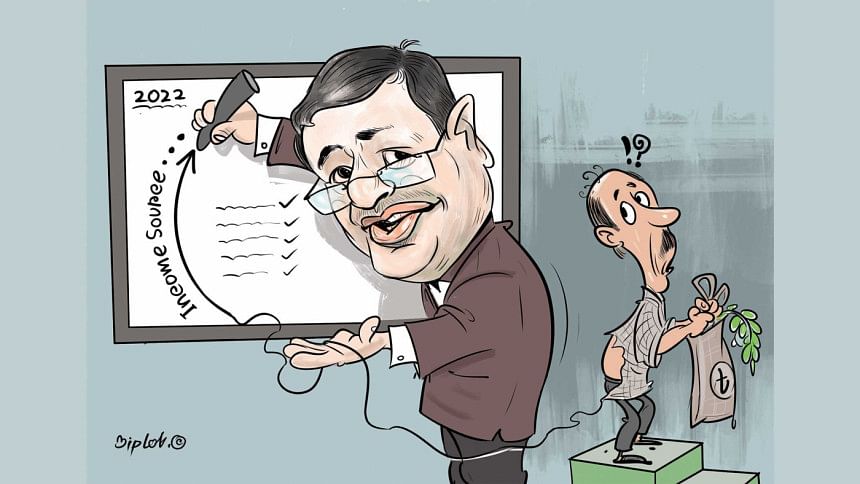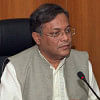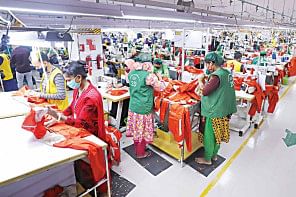If my buying capacity triples and I don’t know it, does it still count?

Apparently, it does. According to the Bangladesh Bureau of Statistics (BBS). And according to Information Minister Dr Hasan Mahmud.
On March 6, the information minister made news landfall with an appearance at a public meeting where he said, "In the last 13 years [that Awami League has been in power], per capita income has seen over a fourfold increase, while people's purchasing capacity has almost tripled. Everyone is doing well now." Three days before, citing the same data from what could only be the ever-agreeable BBS, he had said, "Prices of commodities are not an issue, the issue is if people can purchase them," suggesting that they can.
I usually try not to read too much into political comments made in public meetings. But that one by the information minister stuck with me. Is it possible that we've all been magically transported to some socialist utopia with no poverty? Or is this how the administration is justifying the astronomical prices of daily essentials these days—putting the onus on the public, rather than those manipulating the prices? Or should we take comfort in the fact that while the aam public may be poor, they won't at least die looking like one on paper?
I will be honest: I'm no economist or data expert. My knowledge is as good as that of my nine-to-fiver neighbour, or countless others whose idea of data is limited to how many boxes on their monthly to-buy list have been ticked. Increasingly, however, that list is becoming the financial equivalent of triage with relatively pricier items being left out. It requires no special skill to understand that the rosy picture painted of our apparent financial prowess hasn't benefited everyone in the country—certainly not the poor or the vast majority of the so-called middle class.
The last several months have been particularly taxing. First, there was the hike in diesel and kerosene prices in November. Then, there was the talk of raising the prices of electricity, gas and fertilisers by March, followed by the proposal to raise the price of water by July 1. All this—coming in rapid succession—coupled with a lack of regulatory interventions saw prices of almost all food items, including wheat, rice, onion, lentils, chickpeas and other essentials, shoot through the roof, not to mention increasing the transport fares and agricultural production costs. This was, in other words, a template for how to totally lose control over a market notoriously susceptible to supply concerns and manipulations.
The final straw, coming against the backdrop of Russia's war in Ukraine, was the disappearance and subsequent price gouging of soybean oil (or what little was available) in the retail market. This was succinctly described in the heading of an editorial by this daily: "Out of reach, out of control."
Traders are citing high import costs and duties, as well as supply concerns in the middle of the Russia-Ukraine war, as reasons for the high domestic prices of commodities. True, for many essential items, including edible oil, Bangladesh has to depend on the international market. According to the UN food agency Food and Agriculture Organization (FAO), world food prices hit a record high in February—a 20.7 percent increase year-on-year—led by a surge in the prices of vegetable oils and dairy products. This data was mostly compiled before the Russian invasion of Ukraine, which then sent a shockwave throughout the world. Further compounding the crisis was the US ban on Russian oil imports following other harsh sanctions. All this is bound to have a distressing effect on the global supply chain and prices.
But all this is also a mostly recent development. It doesn't explain the hike in the prices of products grown or manufactured locally, or imported before the war. This, experts say, defies logic as the war, which started on February 24, wasn't supposed to have an immediate impact as there is around a three-week lag for such events to affect import. Currently, according to the Trade and Tariff Commission, the country has an annual demand for two million tonnes of edible oil. Some 2.7 million tonnes of edible oil were imported in 2021. As such, we should have adequate reserves of edible oil. Commerce Minister Tipu Munshi had already assured that there were more supplies of essential commodities than needed. Why, then, are their prices still so high?
The reason is simple: market manipulations, which traders and dealers can do at the slightest excuse, their job made easier by the absence of a functional central oversight mechanism. Sometimes we hear of raids to check hoarding tendencies and other irregularities. But these are so random, so infrequent and so poorly coordinated that they hardly put a dent in the rampant manipulative practices. The information minister's comment—shifting the focus from these manipulators to the customers—is thus an apt reminder of the woeful lack of preparation, and even willingness, of the government to take on the traders. It appears it would rather hand over the reins to them than confront them in the manner that it deserves.
One proven strategy for putting a positive spin on this state of affairs has been the use of BBS data. Economists have long decried the absence of reliable economic growth figures and data on the actual financial state of the population. The BBS offers a poor alternative, and now we know why. For example, a recent study by the South Asian Network on Economic Modeling (Sanem) reveals that the food inflation faced by the poor is more than twice the figure that the BBS data claims. It's because the BBS still calculates food inflation based on the old Household Income and Expenditure Survey (HIES) of 2005-06, despite the HIES 2016 being available since 2017. The danger of such inaccurate and exaggerated data cannot be overestimated, as official response almost always depends on it. It gives a false sense of security and confidence.
So when the information minister says the public can ride out the high food inflation with their superior purchasing capacity, you cannot help but ask: Which segment of the population is he talking about? The upper 10 percent who drive up the per capita income, or the lower 90 percent who remain vastly unrecognised?
In reality, the message that his doing-oh-so-well citizens get from this is also threefold: they have to surrender to the whims of these traders and dealers, stop expecting a turnaround in the official attitude, and accept the new normal of astronomical prices.
So, how is the public faring, really? For a proper assessment, you have to get out of the data trap and go out on the streets, or inside the poor and marginally middle-class households. You have to see how the rising living cost is affecting every aspect of their lives—not just their food choices—and the impossible choices they have to make between educational and medical expenses, for example. You have to live their lives and their choices, or at least have the sincerity to understand them.
You can also try to process the morbid scenes of people crying out of frustration or running after the state-run TCB trucks, or jostling for position in front of them, to buy the necessities at lower prices. These scenes are a sad commentary not just on the plight of the poor, new poor and "disguised poor" (the so-called middle class), but also on the total failure of our economic policies to address their situation.
If the administration is sincere about tackling the price hikes, it has to do better. It must do better.
Badiuzzaman Bay is an assistant editor at The Daily Star.

 For all latest news, follow The Daily Star's Google News channel.
For all latest news, follow The Daily Star's Google News channel. 







Comments